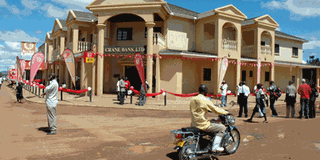Crane Bank to venture into regional markets

Crane Bank’s Iganga branch. File Photo.
What you need to know:
The bank has expanded its branch network to 21 from 18 at the beginning of the year.
As competition for customers in the banking industry hots-up, banks are moving fast to look for business beyond their comfort zones.
Crane Bank intends to expand its footprint into the Democratic Republic of Congo, Rwanda and South Sudan this year to tap into the growing trade between Uganda and her neighbours.
Crane Bank managing director, A.R Kalan, said the institution has already received a license to set up in DRC and are in advanced stages to secure one in Rwanda.
If the plan is fulfilled, Crane Bank will become the first indigenous bank to physically go beyond the confines of Uganda, as other local financial institutions remain reluctant to venture beyond the borders of the country.
The only other indigenous bank that has so far gone beyond Ugandan boundaries, though through a partnership with another bank is Centenary, which recently signed an agreement with South Sudan’s Ivory Bank to facilitate trade between the two countries.
Earlier in the year as Crane bank released their 2011 financials, many bank executives alluded to the fact that they would grow their respective banks’ branch networks this year to increase market penetration.
Mr Kalan, said that since physical branch network makes an important component of the bank’s distribution channel mix, the institution would grow its footprint to 25 branches before the end of this year.
To date, the bank has expanded its branch network to 21 from 18 at the beginning of the year, following the opening of a new branch in Makasa recently.
Mr Kalan said the bank is adequately capitalised, with a paid-up capital of Shs100 billion, which is enough to invest in branch network expansion.
Despite the challenging economic environment that Uganda witnessed in the second half of 2011, Crane Bank was among the so many banks that registered impressive profits.
Crane Bank’s net profit, for instance, was reported to have grown by 29.4 per cent from Shs51.59 billion in 2010 to Shs66.76 billion in 2011, while its loan book grew to Shs524.66 billion from Shs410.18 over the period.
Banking is a location-driven business and branches contribute significant revenue to the overall organisation.
“We believe in opening up as many branches to take services closer to the people and also offer new, affordable and tailor-made banking services,” Mr Kalan said.
Other banks that are undertaking branch network expansion to shore up customer deposits and expand their asset base include Stanbic Bank, which has over 98 branches country-wide, Centenary with about 51 branches, Standard Chartered, Barclays and KCB among others.
Banks had originally shunned expanding banking services to up-country towns as they considered them financially unviable.
The Speaker of Parliament, Ms Rebecca Kadaga, recently urged commercial banks to extend financial services outside Kampala, Wakiso and Mukono districts as a way of deepening financial inclusion.
“Kampala is choking with banks. All these banks don’t want to move out of Kampala thinking that there is no business and money in upcountry towns yet there is huge potential,” Ms Kadaga said at an event to mark Standard Chartered Bank’s 100 years of existence.
However, Mr Kalan said branch expansion comes with a number of challenges including rising costs as banks invest but don’t expect to start reaping immediately.
The other challenge concerns the burden of managing the branch footprint, developing innovative branch formats and optimising service models.




